|
the
Atom Bomb

Introduction
Perhaps no
other aspect of World War II is as controversial as the
decision to drop the atomic bomb on Japan. One thing that
should be made clear is the international and open nature of
scientific inquiry on atomic physics right up to the start
of World War II. This is because no one was trying to make
an atomic bomb, even though many scientists were aware of
the tremendous energy trapped inside the atomic nucleus.
Work was underway in numerous countries to better understand
the atom and perhaps find ways to harness its energy.
In this
desperate new war governments became aware of this potential
source of immense power. Germany, Japan, Britain with
America all had active programs during World War II to
develop atomic weapons. As the theoretical underpinnings of
atomic energy came into focus so did the staggering
complexity of the industrial effort required to make an
atomic bomb. This is where Germany and Japan were left
behind as the United States spent $2 billion to design, test
and manufacture the atom bomb under the Manhattan project.
The U.S.
military was doing its best to defeat Japan even as work on
the atomic bomb was coming to a successful conclusion. By
the summer of 1945 fire-bombing raids by B-29 bombers were
methodically incinerating Japanese cities while a naval
blockade essentially isolated Japan from what was left of
its empire. Operation Downfall, the invasion of the Japanese
home islands was well into its preparation phase as hundreds
of ships gathered at Okinawa.
From a
political stand point it would have been unthinkable not to
use the bomb. All the money and effort going into building a
super powerful weapon that is left on the shelf as American
troops die by the thousands trying to take Japan and end the
war. This is where the debate begins and has never ended
over the morality of using such a terrible weapon.
The Atomic bomb Attacks
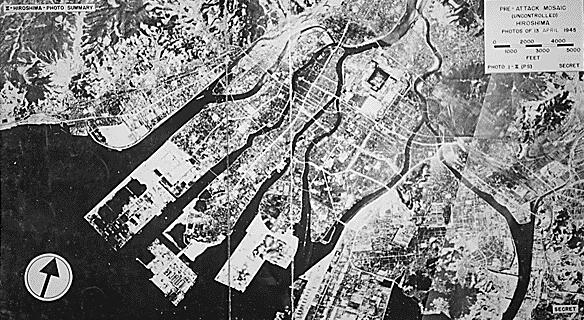
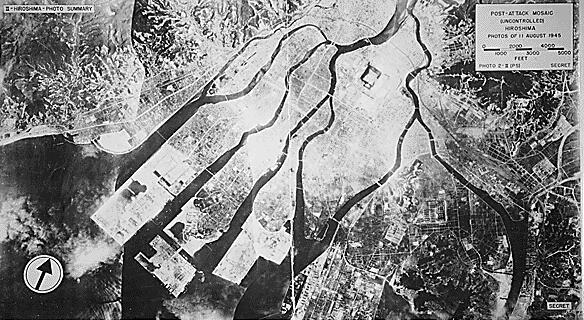
The decision
to drop the atomic bomb was not a group decision, in the end
president Harry S. Truman made it. Among the president's
senior military commanders most felt that a massive invasion
of Japan would probably be necessary to end the war,
although each service still wanted to claim ultimate victory
for itself. The Navy proposed that its ongoing blockade of
Japan would eventually force surrender. Likewise, the Army
Air Force saw victory in continuing the fire bombing raids
by B-29 bombers now numbering close to a 1,000 that were
currently laying waste to huge areas of Japanese cities. Of
course the Army felt strongly that only an invasion and
occupation by troops would secure complete victory.
Truman in
fact approved the invasion of Japan code-named DOWNFALL
before he later decided to authorize the use of the atomic
bomb against Japan. No one knew exactly how the Japanese
leaders would respond to an atomic bomb blast on one or even
several of their cities. Excellent code breaking by the
Americans did reveal however the steps Japanese were taking
and planning to take in defending their country. The likely
number of casualties the armed forces of the United States
would suffer invading Japan was given as 200,000 to a
million men, depending on the source. But everyone realized
including President Truman, who fought in the first World
War, that the number of casualties was more of a guess than
a fact. The atomic bomb was seen as a potentially war
winning weapon and in that hope it was used but no one alive
then truly comprehended its horrifying power.
Hiroshima

The atomic bomb dropped on the
city of Hiroshima was code named Little Boy. The design is
relatively simple using a gun type arrangement to
explosively force a sub-critical mass of uranium-235 and
three U235 target rings together at high velocity causing a
chain reaction.
Well before
dawn on the 6th of August three special reconnaissance
F-13As took off to report the weather over the primary and
secondary targets. Colonel Tibbets lifted the Enola Gay off
the runway at 2:45 A.M. shortly followed by two other B-29
bombers.
Navy weapons
expert Captain William Parsons armed the bomb in flight, as
it had been deemed too risky to arm before take off in case
of accident, possibly wiping out the entire base.
At 7:42 came
the coded message from the Hiroshima weather scout
recommending bombing the primary target. Enola Gay was now
at 26,000 ft and in a slight climb at a little less than 200
miles an hour. For the first time, his crew was told that
they were about to deliver an entirely new type of weapon of
staggering destructive power.
At 8:05
Enola Gay was coming in at 30,800 ft, followed by the
observer planes, and less than 50 miles from Hiroshima.
Major Thomas Ferebee, the bombardier, took up position in
the Plexiglas nose to fix the crosswire of his sight on the
city's T-shaped Aioi Bridge.
Through the
shimmering haze, Ferebee made out the bridge and locked the
cross hairs of his bombsight. The final fifteen seconds to
bomb drop were automatic. At seventeen seconds past 8:15,
the bomb bay doors opened and "Little Boy" plummeted free.
At 1,800 ft,
the barometric pressure device triggered the detonating
mechanism. In a few milliseconds a brief flash had become an
engulfing ball of light and destructive energy.
With this
release of apocalyptic power 75,000 people were killed and
48,000 buildings destroyed. Strategic air power reached a
terrifying new level of destruction in the smouldering ashes
of Hiroshima.
Comparison of Atom Bomb
Attacks with other Bombing Raids
Data from
the US Strategic Bombing Survey, Japanese official counts,
and U.S. government / military documents assessing the
damage caused by these weapons.
| Target |
Hiroshima |
Nagasaki |
Tokyo Fire Raid |
Average of 93
Attacks on Cities |
| Dead/Missing |
70,000-80,000 |
35,000-40,000 |
83,000 |
1,850 |
| Wounded |
70,000 |
40,000 |
102,000 |
1,830 |
| Population Density |
35,000 per sq mile |
65,000 per sq mile |
130,000 per sq mile |
? |
| Total Casualties |
140,000-150,000 |
75,000-80,000 |
185,000 |
3,680 |
| Area Destroyed |
4.7 sq mile |
1.8 sq mile |
15.8 sq mile |
1.8 sq mile |
| Attacking Platform |
1 B-29 |
1 B-29 |
334 B-29s |
B-29s |
| Weapon(s) |
'Tall Boy' 15 kT (15,000
tons of TNT) |
'Fat Man' 21 kT (21,000
tons of TNT) |
1,667 tons |
1,129 tons |
Notes:
Many of the wounded in the atom bomb attacks would die in
the coming days, months and even years due to radiation
exposure and burns.
The terrain and spread-out
nature of Nagasaki reduced destruction of life and property
somewhat despite Fat Man's greater destructive power.
Nagasaki
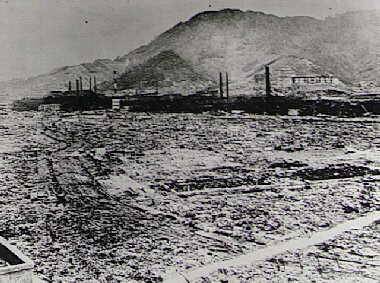
The atomic
bomb dropped on Nagasaki was code named Fat Man and used
plutonium as the fissionable material. Plutonium is a
man-made element that is more efficient than uranium as a
fission source. The design is also more complicated than the
Little Boy atomic device. It relies on a rapid and
simultaneous implosion of a fissionable shell into a
critical mass.
A B-29
bomber named "Bock's Car" took off on August 9, 1945 to drop
another atomic bomb. This 10,000 lb weapon was known as "Fat
Man" and promised by its design to be even more destructive
than "Little Boy." Fat Man detonated 1,650 ft (500 m) over
Nagasaki with the force of 21 thousand tons of TNT at 11:06
am.
The
explosion over Nagasaki was more powerful but the terrain
and layout of the city resulted in fewer deaths. Still,
40,000 were killed instantly and 45,000 more would die later
from burns and radiation. The previous day Russia had
declared war on Japan and launched a huge offensive
involving thousands of tanks and self propelled guns.
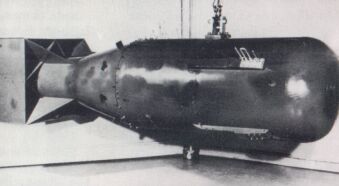
Name: Little Boy
Type: Uranium gun-type fission
Weight: 9,700lb (4400 kg)
Length: 10 ft, 6 in (3.2m)
Diameter: 29 in (0.737m)
Explosive Yield: 15,000 tons of TNT
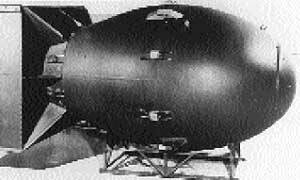
Name: Fat Man
Type: Plutonium fission
Weight: 10,000lb (4535 kg)
Length: 10 ft, 8 in (3.25 m)
Diameter: 5 ft (1.52 m)
Explosive Yield: 21,000 tons of TNT
Manhattan Project
Introduction
On 2 August
1939 some scientists wrote to President Roosevelt of efforts
in Nazi Germany to purify Uranium-235 with which might in
turn be used to build an atomic bomb. It was shortly
thereafter that the United States Government began the
serious undertaking known only then as the Manhattan
Project. The Manhattan Project was designed to research and
production that would produce a usable atomic bomb. The
Project was named after the Manhattan Engineer District of
the US Army Corps of Engineers, because a lot of the early
research was done in New York.
In 1942
General Leslie Grove was chosen to oversee the project while
the brilliant young physicist Robert Oppenheimer was
appointed to lead the scientific team.
Initial
Research
This came in
the latter part of 1942 with work done at Chicago University
led by Enrico Fermi. He developed and brought to life the
world's first atomic reactor (atomic pile.) In affect this
was a slow motion atomic bomb proving that the concept and
scientific principles were sound. The atomic reactor
undergoes nuclear fission (the same process that powers an
atomic bomb) but, of course, under controlled conditions.
Testing
A remote
site on the Alamogordo Bombing Range, code named Trinity was
chosen to test the world's first atomic bomb. Stationed on
top of a 100-foot tall steel tower was a plutonium implosion
device ( Fat Man type atomic bomb ) It was detonated at
5:29:45am on July 16, 1945. The explosion vaporized the
tower, left a 300 foot wide crater some 8-10 feet deep and
released energy equivalent to 15,000 - 20,000 tons of TNT.
The Trinity site is located about 120 miles (193 km) south
of Albuquerque, New Mexico.
|
